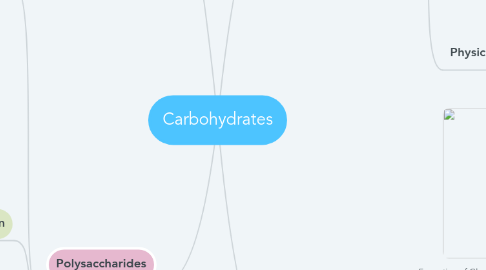
1. Polysaccharides
1.1. Starch
1.1.1. Amylose (Alpha, straight chain polymer)
1.1.1.1. 1. Unbranched, linear polymer (helix shape), hydrophobic
1.1.1.2. 2. has a reducing and non-reducing end
1.1.1.3. 3. Most OH groups are on the interior of the helix, thus cross linkage of amylose not possible
1.1.1.4. 4. Poorly Soluble in room temperature
1.1.1.5. 5. in HIGH TEMPERATURE amylose chains are more soluble as hydrogen bonds are broken, resulting in higher solubility
1.1.1.6. 6. Reacts with iodine to give dark blue colour and Iodine inserts itself into the middle of the hydrophobic amylose helix
1.1.2. Amlopectin (Alpha, branched chain polymer)
1.1.2.1. 1. highly branched (has both linear and branched linkages)
1.1.2.2. 2. poorly soluble in water but more soluble than amylose - branching decreases ability of the chains to get together with one another and increases binding of water molecules to chain
1.1.2.3. 3. Reacts with iodine to form red-violet colour
1.2. Glycogen
1.2.1. 1. Storage polysaccharide in Animals
1.2.2. 2. Branch chain polymer (more branched than Amylopectin)
1.2.3. 3. Glucose is solvated with water molecules and therefore more easily hydrolysed than starch, and thus can meet the higher metabolic demand of the tissues compared to starch
1.3. Cellulose
1.3.1. 1. Linear polymer composed of Beta glucose
1.3.2. 2. Alternating 180 degree flips along the chain allows multiple hydrogen bonds to form between adjacent, parallel strands of Cellulose
1.3.3. 3. flattened sheets of chain lie side by side and are joined by hydrogen bonds between hydroxyl groups projecting from both sides
1.3.4. 4. Sheets are laid on top of each other in a staggered formation to give strength --> this causes cellulose to be extremely resistant to hydrolysis (both acids an amylases)
1.3.5. 5. Inter molecular hydrogen bonding between cellulose molecules results in microfibrils
1.3.6. 6. microfibrils associate with one another to form macro fibrils, and macro-fibrils combine to form cellulose fibres. -Cellulose fibres form meshwork, that distribute stress in all directions --> arise to great tensile strength and provides support, mechanical strength that prevents plant cells from bursting when placed in a solution of higher water potential
2. General information
2.1. General formula: CH2On (n= no. of carbon-hydrate groups)
2.2. Glycolipid (carbohydrate+lipid)- components of biological cell membranes
2.3. Glycoproteins (carbohydrate+protein)- 1.Components of cell wall 2.Extracellular structures in plants/animals/bacteria. 3.Cell recognition (recognition of cellular structures of other molecules)
3. Monosaccharides
3.1. Distinguised by presence of Carbonyl group (C==O) and hydroxyl group (OH)
3.2. The carbonyl and hydroxide functional groups provides sugars an array of reactive and hydrophilic functional groups
3.3. Diversity arises from position of -carbonyl group -number of carbon atoms in the chain -configuration of hydroxyl groups
3.4. Ring formation
3.4.1. -predominant form of carbohydrates -bond responsible for ring formation occurs between the carbon containing the carbonyl group and the carbon with the hydroxyl group
3.4.2. Alpha and Beta glucose
3.5. Chemical properties of monosaccharides
3.5.1. Benedict's Test -In order for oxidation to occur, cyclic form must open up to give reactive aldehyde (stereo centre carbon is bonded to O,H an and a R-side chain.
3.5.1.1. Monosaccharides+ some disaccharide are reducing sugars (can be oxidised to give carboxylic acids)
3.6. Physical properties
3.6.1. 1. Soluble in water+ have a low molecular weight --> able to exert osmotic pressure
3.6.2. in plants, sugars are transported as sucrose and not glucose (a) Increased energy storage (b) sucrose is not as reactive as glucose

